I’ve been playing games regularly for 25 years, and in that time I’ve really dialed in on what I like and don’t like when it comes to board games. And despite today’s game being an online only abstract game that is (or at least seems to be) incredibly random (all traits I usually avoid in board games)–it is also one of my all-time favorites.
Play Quadradius online HERE
Quadradius is a browser game that was available online from 2007 to 2021 (active until Flash stopped working in 2021) until it was thankfully resurrected by the Quadradius Preservation Project this May after being offline for 3 years. Usually described as “Checkers with super powers,” you can perhaps better think of it like playing Chess with 20 kings (that can not move diagonally) on each side. Each piece can move one space orthogonally, and if you move onto an opponent’s piece, that piece is removed from the game. Here is the starting setup:
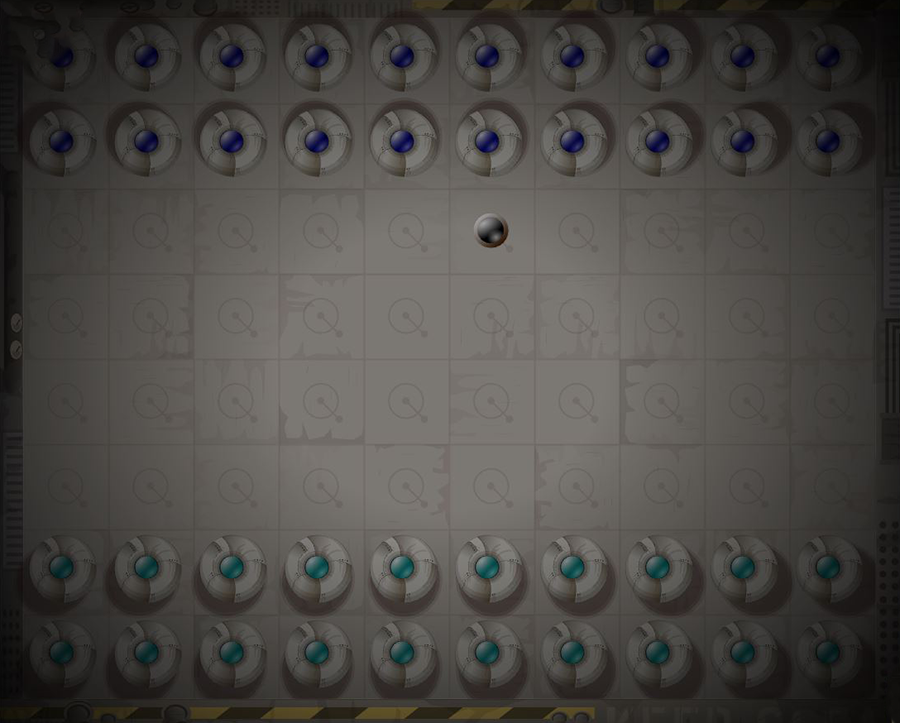
Following “Chess with only orthogonally moving Kings” rules…after 20 moves your board will look like this–a stalemate for the pieces in the middle of the board as none can move forward without being “jumped”:
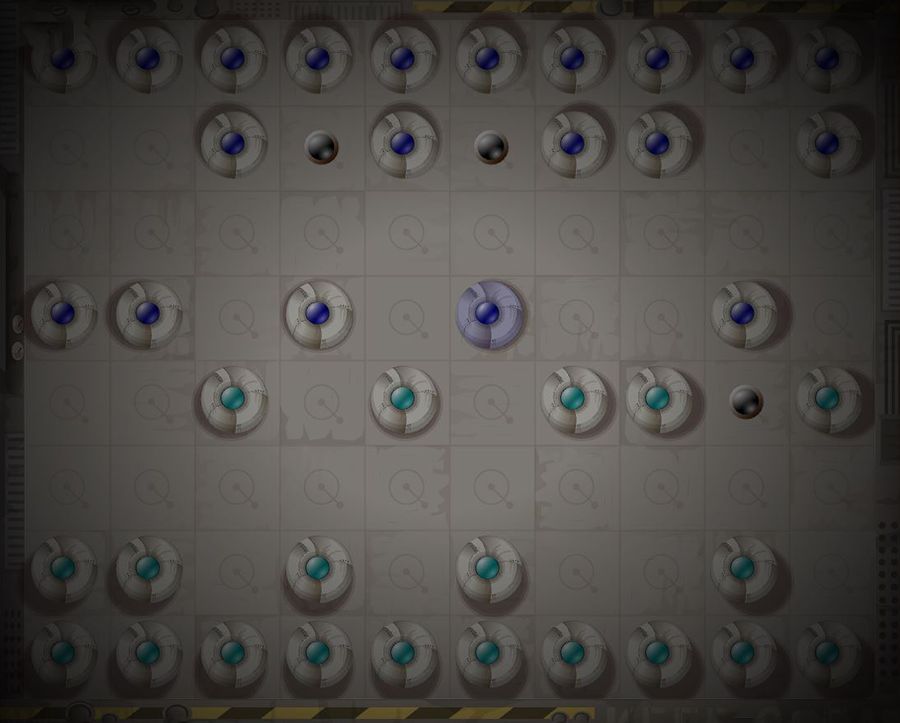
A game like this would be about as uninteresting as they come–and this is where the “power orbs” come into play. Spawning every 7 rounds in random locations, the power orbs can be any of 86 (!) random abilities that affect your pieces and the board itself in many different ways. Notice that little black orb in the first picture next to the blue team? The blue piece in the sixth column “picked it up” as it moved down the board, which is why that piece is shaded blue in the second picture. This means it has an unidentified (to the opponent–you can always immediately see your own powers) power that it can activate on future turns. In this case, its power is “Acid Radial” a power that covers all enemy pieces in the 8 squares diagonally and orthogonally adjacent to the piece in acid:
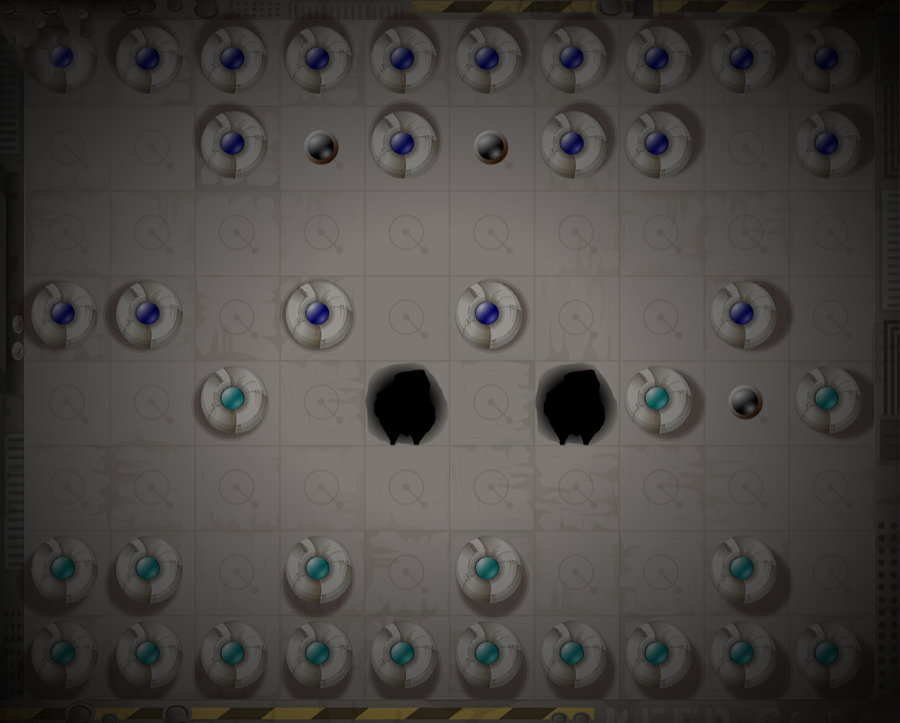
Not only has this destroyed the two pieces across from it, but it has also left two permanent holes in the board making those squares unusable for the rest of this game. This board alteration (and your ability to choose when and where to activate the acid power) has already broken the stalemate, and from there the game quickly becomes more interesting–like when blue moves its piece in the third column forward to take the orb on the second row. This time the power is Bombs…one of the more random powers in the game where small bombs fall out of the sky destroying pieces and tiles indiscriminately:
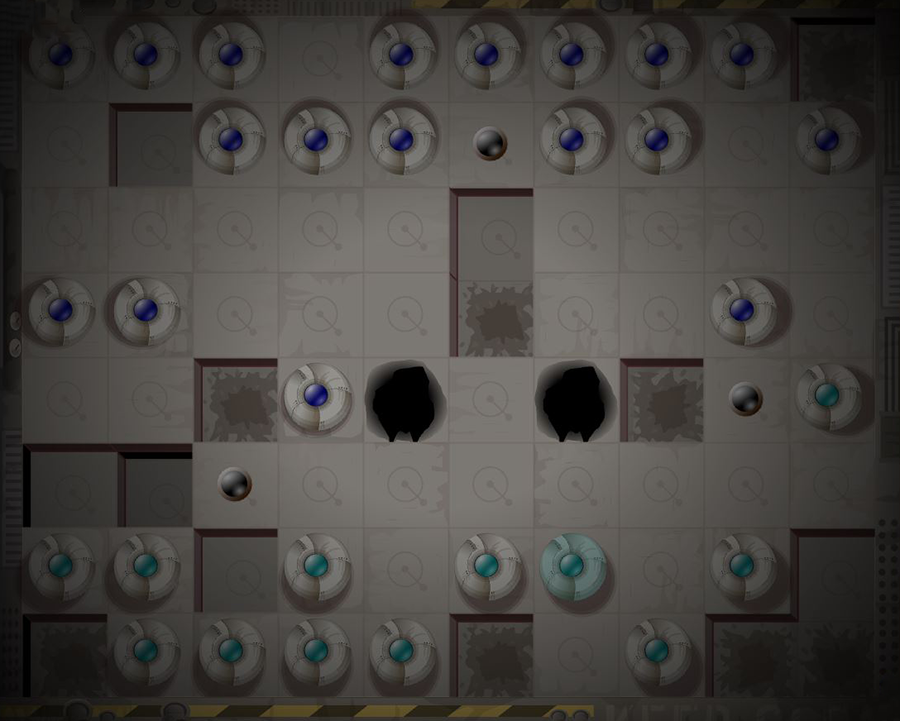
Blue got lucky with the bombs as it only lost two pieces while five of the opponents pieces were destroyed. Also, notice that all tiles where a bomb landed have been depressed one level. Pieces in Quadradius can move down any number of levels, but can only move up one level at a time, so these depressions do not affect movement (yet). But when Teal activates a “Dredge Column” power causing the opponent’s pieces in the same column to sink two levels (trapping them) while raising friendly pieces in that column two levels (making them safe from jumps) now the 3d board begins to have an effect on play:
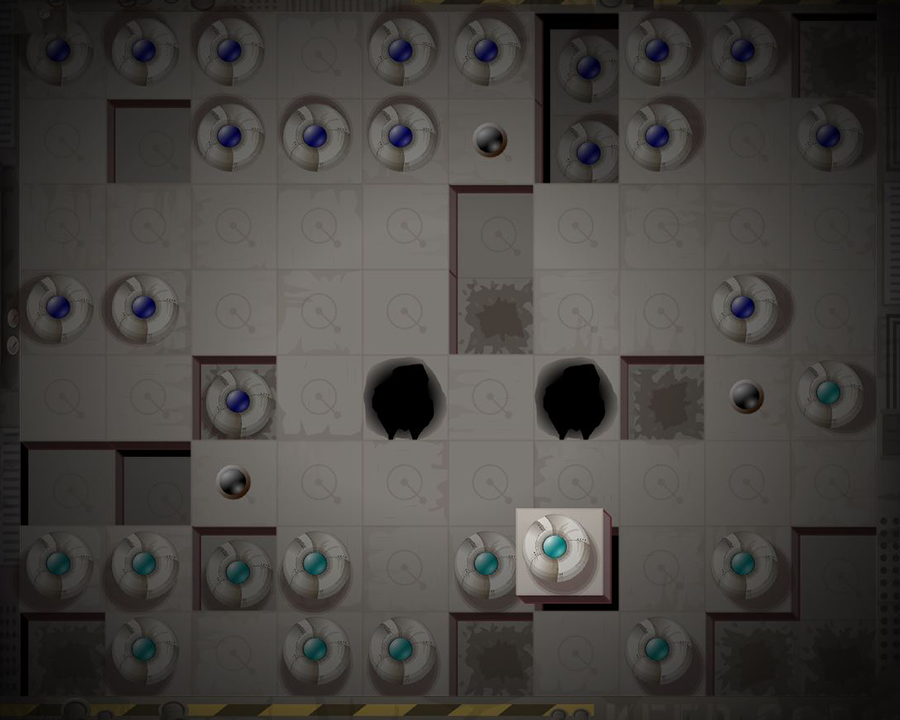
This is only 25 moves into the game but already the stalemate is falling apart and the board is full of decisions. Each new power that is activated adds to these decisions until instead of a stalemate of kings, you’ve got a three dimensional board full of potentially lethal problems.
This is where the tactics of Quadradius begin to reveal themselves. First, yes, it is random. You could activate “Bombs” and all 16 bombs that fall could hit your own team (though the odds here would be pretty ridiculous). Your opponent could activate “Relocate” and randomly teleport next to your most powerful piece and jump it. Your opponent could get “Jump Proof” (making the piece that activates it immune to jumping for the rest of the game) as its first orb while you get stuck with a weak “Lower Tile” as your first pickup.
However, this randomness is deceptive. Because you have 20 pieces, and a rough guess of about 80 orbs spawning over the course of the game, you can lose 3/4ths of your team and still be able to come back with a powerful orb spawn (in fact, the more pieces you lose from the territory you control, the more spaces you have for the random orb spawns to appear at). If Quadradius were played on a smaller board with only 4 pieces per side, then the first piece to pick up a “good” power orb would win. But this is not the case for the 10×8 board with 20 pieces per side.
The more you play, the more the game reveals itself to actually be a territory control game with strong bluff elements. The more territory you control, the more orbs will spawn on your side, and the more orbs you get over the course of the game the more likely you are to win. Then, when you DO get an orb-enhanced power piece, the bluff element comes into play. A good third of the orb drops you get are “kill” powers, so every orb my opponent gets will make me worry that it is a column/row/radial kill power that will take out my power enhanced piece. Did they move just move diagonally adjacent to me? It might be a radial power, so I might try to move away to the side to keep my piece safe before they activate their power on their next turn (powers must be activated before moving). Of course, they could be bluffing and I just moved into a column across from one of their column kill powers instead–just like they hoped I would do.
A new player that gets massacred by some ridiculous combo might claim the game is too random, but having played hundreds (thousands?) of games of Quadradius over the last 15 years I can confirm that the GOOD players (which is a group that doesn’t necessarily include me) will win the majority of the time. It’s a random game, but is has enough time and space for the randomness to even out letting good play win most of the time.
Of course, sometimes your opponent will end up getting some ridiculous combo that “Teaches” his entire back row the powers “Move Diagonal” (powerful, obviously) and “Grow Quadradius” (the best power in the game as it massively increases the range of kill powers) and traps you in a kill zone of expanded “Destroy Rows” and “Dredge Columns”:
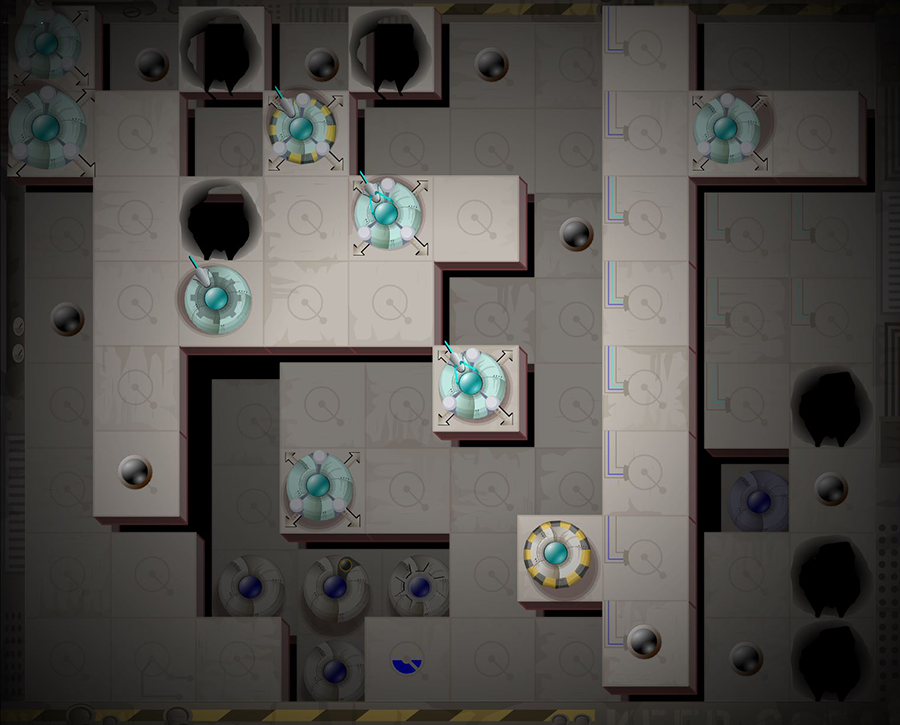
So, of course EVENTUALLY the randomness will win out, but most of the time it wins out BECAUSE of strong play, not despite it. How long can you hold on and bluff your way to the perfect power combination? The randomness also lets new players stay competitive. All it takes is one opportune “Snake Tunneling” (a power that sends a random snake of destruction out across the board, raising tiles 2 levels in the process) and game you were losing can turn around.
Not that pure randomness is even a bad thing. In a recent game with my son he used “Teach Row” to teach his entire back row the power “Tripwire Column” and proceeded to “Tripwire” (put wires on a piece that will make it explode if it moves) my entire side of the board. However I had a “Purify” (removes negative effects) and saved two pieces and then picked up an “Invisible” and proceeded to win the game anyway. I’m not saying that was strong play from either of us, but it was definitely fun!
Finally, Quadradius is not a real board game (obviously) as it can only be played online. And I’m someone that hates playing online, part of the appeal of board games for me is the face to face interaction, and this is doubly so for Quadradius–a game that you really kind of need to hear the groan of disgust from your opponent when you “Recruit” their best piece to your side. Playing silently with randos on the internet just doesn’t hit the same. However, most of my games are played with friends (along with a side chat or video/voice call) or in the same room with my son on another computer. Played this way, Quadradius is a board game experience unlike any other, and one that I’ve never grown tired of, even when my opponent “Pilfer Columns” one of my pieces that just picked up a “Grow Quadradius” along with its “Destroy Column” and “2x”.

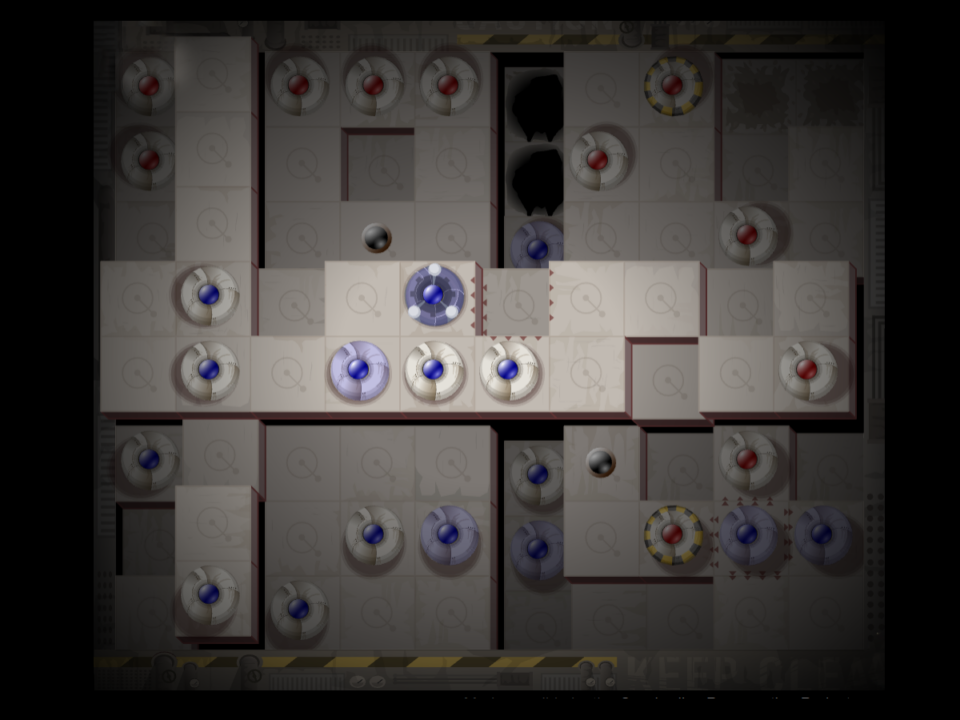
Leave A Reply